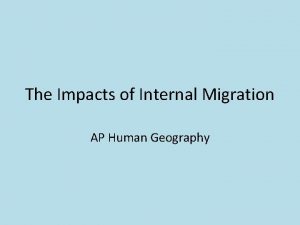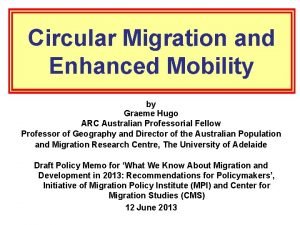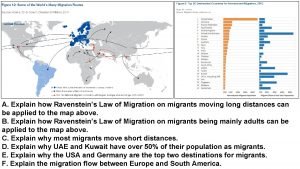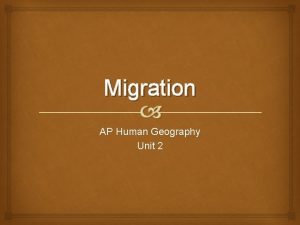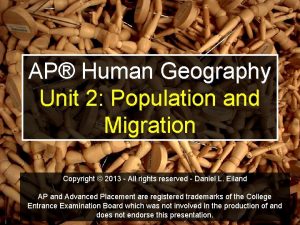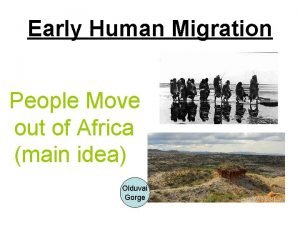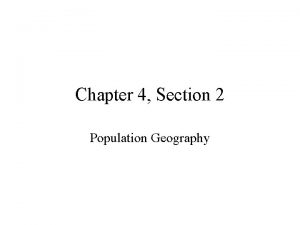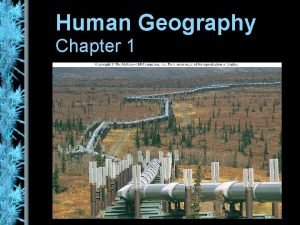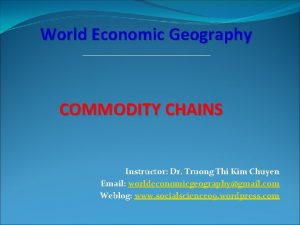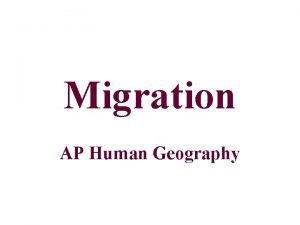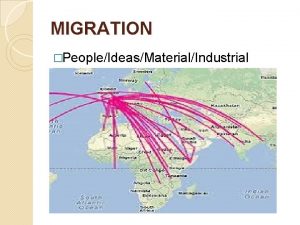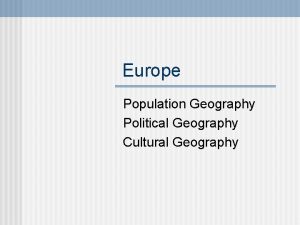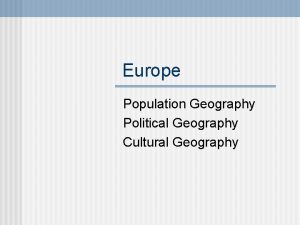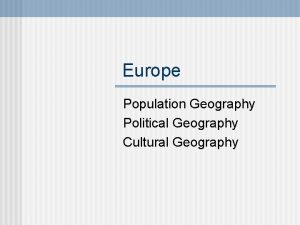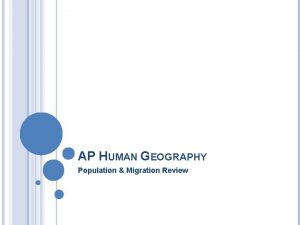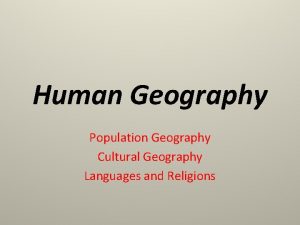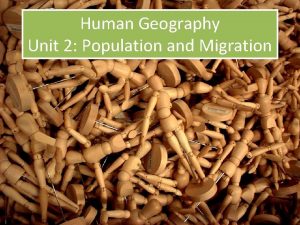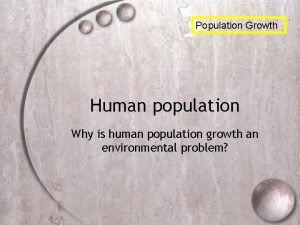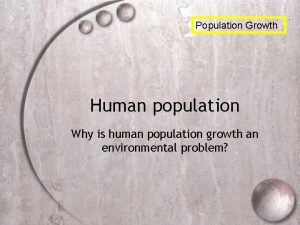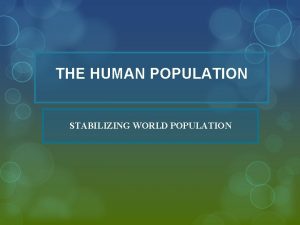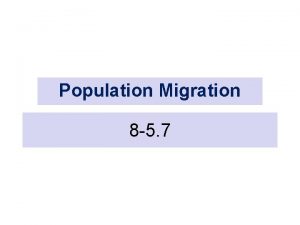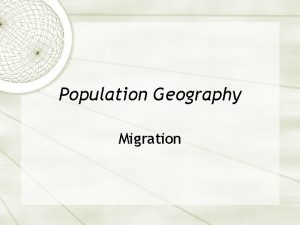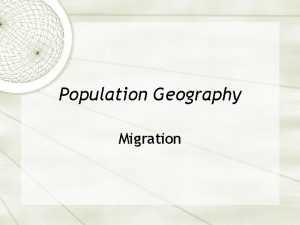AP Human Geography Unit 2 Population and Migration































- Slides: 31

AP® Human Geography Unit 2: Population and Migration Copyright © 2013 - All rights reserved - Daniel L. Eiland AP and Advanced Placement are registered trademarks of the College Entrance Examination Board which was not involved in the production of and does not endorse this presentation.

Overview Population Unit 2 Migration

Part 1: Population

Where is Everyone? Overpopulation Sections Why is population increasing at different rates? Where has population increased?

Section 1: Where Is Everyone?

What is demography?

Create your own definition: Demos (Greek for “People”) + graphe (Greek for “to describe”)

What is population distribution?

“Population distributions are descriptions of locations on the Earth’s surface where individuals or groups live. ”

In what places on Earth do you expect to find the most people living? What common traits might these places exhibit?

What is ecumene?

“Ecumene is the portion of the Earth’s surface occupied by permanent human settlement. ”

Common Traits of Ecumene Almost 90% of all people live north of the equator. More than half of all people live on about 5% of the land, and almost nine-tenths on less than 20%. Most people live in areas close to sea level. About two-thirds of world population is concentrated within 300 miles of the ocean.

How do you measure population?

“You measure population by looking at Population Density; the number of people occupying an area of land. ”

Arithmetic Density • The total number of people in an area. • Population divided by Land Area Physiological Density • The number of people supported by a unit area of arable land. • Provides insights into the relationship between the size of a population and the availability of resources in a region. Agricultural Density • The ratio of the number of farmers to the amount of arable land.

Discuss how the agricultural density of the United States may have changed over the last 200 years.

Two-thirds of the World’s Population is concentrated in four specific areas.

East Asia China, Japan, the Korean Peninsula, and Taiwan

South Asia India, Pakistan, Bangladesh, Sri Lanka

Southeast Asia The islands of Java, Sumatra, Borneo, Papua New Guinea, Philippines, Indonesia

Europe Largely concentrated in urban areas.

Section 2: Where has the World’s population increased?

How do you measure population change?

“You can measure population change through the Crude Birth Rate, the Crude Death Rate, and the Natural Increase Rate. ”

The Crude Birth Rate (CBR) is the total number of live births a year for every 1, 000 people alive in the society.

The Crude Death Rate (CDR) is the total number of deaths a year for every 1, 000 people alive in the society.

The Natural Increase Rate (NIR) is the percentage by which a population grows in a year.

NIR = (Crude birth rate − Crude death rate) / 10

The Total Fertility Rate(TFR) is the average number of children a woman will have during her childbearing years.

The Infant Mortality Rate (IMR) is the annual number of deaths of infants under 1 year compared with total live births.
 Internal migration definition ap human geography
Internal migration definition ap human geography Intraregional migration ap human geography
Intraregional migration ap human geography Circular migration definition ap human geography
Circular migration definition ap human geography What is ravenstein's law of migration
What is ravenstein's law of migration Gii definition ap human geography
Gii definition ap human geography Mobility ap human geography
Mobility ap human geography Eugenic population policies definition ap human geography
Eugenic population policies definition ap human geography Frq ap human geography format
Frq ap human geography format 5 themes of geography ap human geography
5 themes of geography ap human geography Stateless nation
Stateless nation Gni definition ap human geography
Gni definition ap human geography Cartogram definition ap human geography
Cartogram definition ap human geography Folk culture ap human geography
Folk culture ap human geography Sequent occupance ap human geography examples
Sequent occupance ap human geography examples Cultural landscape ap human geography example
Cultural landscape ap human geography example Gis definition ap human geography
Gis definition ap human geography Pidgin language ap human geography
Pidgin language ap human geography Cbr definition ap human geography
Cbr definition ap human geography Flows definition ap human geography unit 1
Flows definition ap human geography unit 1 Chapter 4 section 1 population dynamics
Chapter 4 section 1 population dynamics Section 1 population dynamics answer key
Section 1 population dynamics answer key Population ecology section 1 population dynamics
Population ecology section 1 population dynamics Chapter 4 section 1 population dynamics study guide answers
Chapter 4 section 1 population dynamics study guide answers Human migration map
Human migration map Chapter 4 section 2 population geography
Chapter 4 section 2 population geography Unit 10, unit 10 review tests, unit 10 general test
Unit 10, unit 10 review tests, unit 10 general test Rectangular survey system ap human geography
Rectangular survey system ap human geography Township and range aphg
Township and range aphg Metes and bounds ap human geography
Metes and bounds ap human geography Township and range definition ap human geography
Township and range definition ap human geography Metes and bounds survey system ap human geography
Metes and bounds survey system ap human geography Human and economic geography
Human and economic geography
